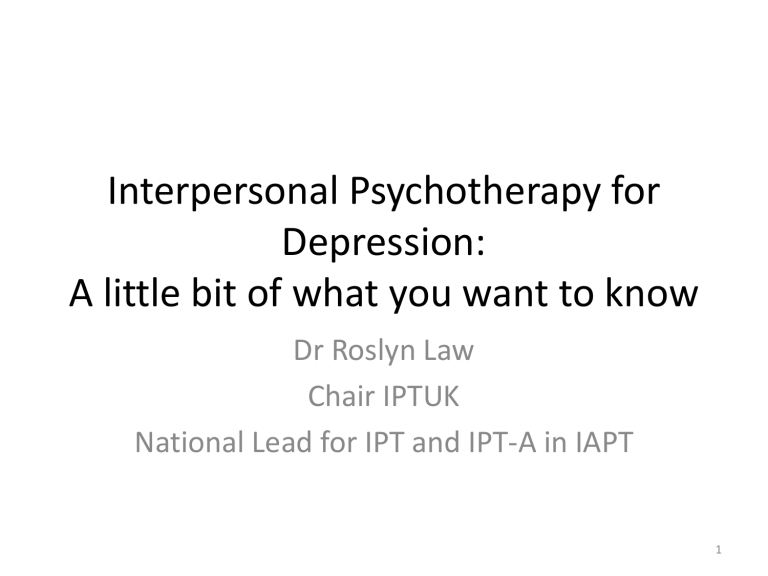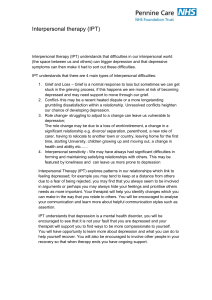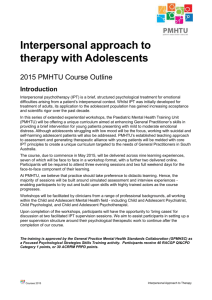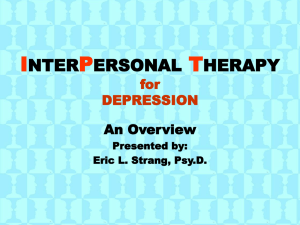IPT - Healthcare Conferences UK
advertisement

Interpersonal Psychotherapy for Depression: A little bit of what you want to know Dr Roslyn Law Chair IPTUK National Lead for IPT and IPT-A in IAPT 1 Weissman MM (2006) A Brief History of Interpersonal Psychotherapy. Psychiatric Annals, 2 36: 8, 552-557 Translate depressive symptoms into the interpersonal context Depression Interpersonal 3 IPT two main objectives To resolve interpersonal problems linked to the onset and continuing symptoms To reduce symptomatic distress 4 What is IPT? www.ucl.ac.uk/clinical-psychology/CORE/IPT_framework.htm Depression Interpersonal Context Social Support 5 6 IPT: What does it do? o IPT focuses on the relationship difficulties that are often very important to people experiencing depression and that are frequently identified as key features of their depression stories o IPT is primarily interested in the current conflicts, role changes, losses and difficulties in establishing and maintaining independent and satisfying relationships that so often trigger and maintain episodes of depression 7 TRAJECTORY Initial sessions 1-4 Middle sessions 5-2 Chosen focal area: • Grief • Interpersonal Disputes • Role Transitions • Interpersonal Sensitivity/Deficits PROCESS Diagnosis Interpersonal Inventory Interpersonal formulation Contract Monitoring symptoms Interpersonal work Specific Techniques Conclusions of acute treatment Sessions 12-16 Separation responses Review of progress Resilience planning Contingency planning Maintenance (6mo-3years) Maintenance contract Prevention of relapse 8 Symptoms Interpersonal Inventory Focus Selection Contract Clear statement of focus, goals and expectations Prepare for future sessions and predictable challenges Psychoeducation Populate timeline of depression Inform formulation Guide to symptom discussion Weekly symptom review Patient as expert Review of current resources Review of current difficulties Guide to interpersonal discussion Timeline Decision re a/d meds & review schedule Social model of depression Clarify moodinterpersonal link Clarify moodinterpersonal link History of depression and treatment Initial symptom relief Mobilize available resources Assist focus selection Clarify treatment targets/goals Assist focus selection Sick role Diagnosis Work on ending 9 Role Transition Role Disputes Grief Sensitivities Weekly symptom review Weekly symptom review Weekly symptom review Weekly symptom review Link symptoms to focal area Link symptoms to focal area Link symptoms to focal area Link symptoms to focal area Review +/- of old and new roles Clarify communication problems Reconstruct and evaluate lost relationship Clarify recurring interpersonal problems Explore process of changes and affect Identify key issues and expectations Review and evaluate social support then and now Use therapeutic relationship as a model Develop current relationships and skills Explore parallels across relationships Develop involvement with current network Develop new satisfying relationships 10 Explicit discussion of ending Explore feelings about ending and potential loss Review progress and highlight competence Evaluate therapy Maintenance plan Relapse prevention plan 11 Mechanisms of change in IPT Lipsitz & Markowitz (2013) o Enhancing social support o Develop resources and context to be soothed, contained and find meaning o Decreasing interpersonal stress o Target key interpersonal stressors and ameliorate negative contextual influences o Facilitating emotional processing o Development capacity for emotional awareness and regulation as a means of engaging interpersonal resources o Improving interpersonal skills o improving or adapting interpersonal skills essential to successful resolution of the current crisis or predicament. Training in Evidence Based Practice + Research evidence Patient + values + preferences + Clinician observations Quantifiable results Utility for clinicians Acceptable to recipients Frueh et al (2012) Evidence-Based Practice in Adult Mental Health. Handbook of Evidence-Based Practice in Clinical Psychology. Published = online. 13 Clinical evidence for IPT Author Number of participants Number of sessions/duration Elkin et al (1989) 239 16 weekly plus optional 4 extra sessions Frank et al (1990) 128 12 weekly, 12 fortnightly, 3 years monthly Weissman (1992) 35 6 sessions Schulberg et al (1996) 276 16 weekly, 4 monthly continuation sessions Reynolds et al (1999) 80 8 weekly, 16 fortnightly, 2 years monthly Reynolds et al (1999b) 107 Treat to remission, 16 fortnightly, 3 years monthly De Mello et al (2001) 35 16 weekly, 6 monthly Freeman et al (2002) 124 16 sessions Reynolds et al (2006) 165 2 years Van Schain et al (2006) 143 5 months Blom et Al (2007) 193 12 sessions Luty et al (2007) 177 16 sessions 14 Outcome data sample o PHQ-9 & GAD-7 data were gathered for a intention to treat sample of IPT patients in IAPT (London) o 165 patients o 18 therapists o 10 services 15 Cut off scores for Recovery • PHQ-9 : below 10 is cut-off for recovery • GAD-7 : below 8 is cut off for recovery • WSAS:below 8 used as cut off for recovery • Response: 50% reduction from baseline scores 16 Attendance 90 80 80 67,8 70 60 50 40 30 20 13,7 10 0 M no session % Completed 12 or more session 17 Focal Areas 70 63 60 50 40 40 29 30 20 14 10 0 Role Transition Role Disputes Grief Sensitivities 18 % Recovery & Response (50% reduction) at session 8 and 16 70 57,7 60 57,7 55,2 48 50 40 30 34 29,5 29,7 25,9 20 10 0 19 Combined PHQ and GAD % Response and Recovery Rates 60 56,4 52 50 40 30 27 21 20 10 0 Combined recovery8 Combined recovery Combined response Combined response 16 8 16 20 Mean Pre, Mid & Post Scores on PHQ9, GAD-7 & WSAS 23,7 25 20 15 10 18,8 16,2 14,7 13 13,5 12,4 8,3 9,3 10,7 7,4 7,9 5 0 PHQ GAD Baseline Session 8 WSAS Session 16 End 21 Grief: Mean Pre, Mid & Post Scores on PHQ-9, GAD-7 & WSAS 30 25 27 21,4 21 20,2 20 15 16,8 16,6 14,5 12,5 11,2 12,5 11,7 10,4 10 5 0 PHQ Baseline GAD Session 8 Session 16 WSAS End of Treatment 22 Sensitivity: Mean Pre, Mid & Post Scores on PHQ-9, GAD-7 & WSAS 30 24,5 25 20 19,9 17,7 15 15,2 13,2 10,6 10 18 7,9 8,2 10,1 7,7 7,3 5 0 PHQ Baseline GAD Session 8 Session 16 WSAS End of Treatment 23 RD: Mean Pre, Mid & Post Scores on PHQ-9, GAD-7 & WSAS 23,8 25 20 17,8 10 5 14,9 14,4 15 9 8,8 8,1 5,2 5,3 6,2 9,1 5,5 0 PHQ Baseline GAD Session 8 Session 16 WSAS End of Treatment 24 RT: Mean Pre, Mid & Post Scores on PHQ-9, GAD-7 & WSAS 25 20 19,2 17,9 13,9 15 10 10,3 9 8,9 12,9 8,5 7,3 12 12,7 7 5 0 PHQ Baseline GAD Session 8 Session 16 WSAS End of Treatment 25 Outcome data sample • PHQ-9 & GAD-7 data were gathered for a intention to treat sample of IPT patients • 48 patients • 7 therapists • 6 services 26 Mean Pre/Post Scores PHQ-9 & GAD-7 Baseline End 25 20 15 10 5 0 PHQ GAD 27 % Recovery & Response (50% reduction) 90 80 70 60 50 40 30 20 10 0 PHQ recovery PHQ response GAD recovery GAD response Combined recovery Combined response 28 IPT in IAPT Evidence based Collaborative IAPT Routine outcome monitoring Case management and supervision 29 NICE Guidelines recommended Explicitly collaborative in session and between agencies IPT-A Weekly symptom review and Interpersonal goals Collaborative practice and supervision protocol 30 Training Figures 2013-2014 100 90 80 70 Durham 60 Yorkshire and North West 50 West Midlands 40 London 30 South East 20 Total 10 0 IPT Prac IPT-A Prac IPT Sup 31 Case management and supervision o Supervision is a condition of practice o Access to supervision is a condition of attending training o +ve: more than doubled the number of IPTUK registered IPT trainees, practitioners and supervisors during 3 years of IAPT o Limited supervision capacity but growing. Remote supervision (telephone/Skype) remains the norm 32 Case management and supervision • For accreditation – Four cases completed under supervision – Must cover at least two focal areas – All sessions are recorded and three complete sessions are reviewed per case – Self assessment throughout supervision – 15 mins supervision per case per week • Minimum of monthly IPT peer supervision following accreditation • Distance supervision (telephone, Skype) is the norm 33 Challenges of IAPT • A practitioner does not make a service – Where possible two trainees are recruited from each partnership • Service targets v evidence based practice • Ensuring protected time to learn and contribute to service transformation • Baseline numbers of IPT practitioners and supervisors in IAPT are very small • Working across adult and CYP services 34 IPT: In summary • IPT is a time limited, evidence based treatment for depression in adults and adolescents. • It targets key interpersonal issues that trouble many people with depression who seek treatment and collaboratively formulates a treatment plan to focus on their primary relationship difficulties • It monitors symptom reduction and progress towards interpersonal goals on a weekly basis and has been shown to achieve outcomes that are equivalent or superior to existing treatment approaches for moderate to severe depression in people • IPT combined with medication has repeatedly been should to achieve better outcomes in adults than either therapy alone for moderate to severe depression 35 Questions and comments 36





